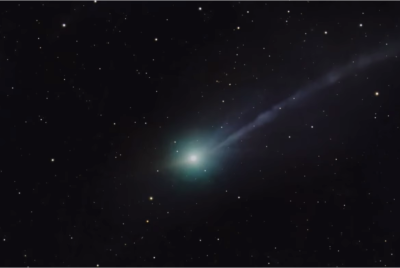3I/ATLAS Update: Search For Extra-terrestrial Tech Fails To Find Signals From Space Object
Radio observations confirm 3I/ATLAS is a natural comet, quashing speculation about extra-terrestrial technology.

The search for extraterrestrial technology around the interstellar object 3I/ATLAS has hit a firm scientific wall, with astronomers reporting that the radio signatures detected near the comet are entirely natural.
Using South Africa's MeerKAT radio telescope, researchers captured faint absorption lines shortly after the object reappeared from behind the Sun, sparking excitement online about a potential artificial signal.
But detailed analysis has now confirmed these frequencies match standard cometary chemistry, not alien communication.
The findings quieten weeks of speculation fuelled by unusual behaviour, shifting brightness and bold theories from high-profile commentators, including Harvard astrophysicist Avi Loeb.
MeerKAT Detects OH Absorption, Not Artificial Broadcasts
The new results centre on two faint absorption lines at 1,665 MHz and 1,667 MHz, recorded on 24 October, shortly after 3I/ATLAS completed its perihelion. According to the International Business Times UK, these frequencies correspond to hydroxyl (OH) radicals created when sunlight breaks down water molecules in a comet's coma.
Coverage in LiveScience adds that the measured frequencies are textbook examples of comet outgassing, not transmission patterns from engineered technology. The Indian Express likewise reports that, while speculation swirled online, observational evidence points decisively to a natural origin.
As IBTimes UK previously noted, the alignment between the detected lines and known OH absorption behaviour leaves virtually no scientific room for an artificial explanation.
Why The Signals Looked Strange At First
The detection was publicised through an astronomer telegram, prompting curiosity because the object had already shown erratic brightness and unusual polarisation.
Some commentators linked the frequencies to the famous 1977 'Wow! Signal', reviving theories aired by Loeb that 3I/ATLAS might be a probe or beacon, as Newsweek reported.
But planetary scientists have dismissed the extraterrestrial leap. ESA comet expert Michael Küppers told The Guardian: 'It looks like a comet and it behaves like a comet. There is no reason to think it is something else.'
Wired explains why the pattern confused some observers: MeerKAT didn't detect a signal being sent. Instead, it picked up a fingerprint of absorption—the natural imprint left behind when solar radiation interacts with a water-rich coma.
More Observations Reinforce A Cometary Identity
Beyond radio data, multiple instruments have strengthened the case that 3I/ATLAS is simply an unusual interstellar comet. Ultraviolet observations from NASA's Neil Gehrels Swift Observatory detected OH emissions, a classic signature of water activity.
Meanwhile, spectroscopy from the James Webb Space Telescope revealed that the coma is extraordinarily enriched in CO₂—among the highest concentrations ever seen in a comet—alongside carbon monoxide, water and dust, according to an arXiv preprint.
Polarimetric studies add a twist: the object displays 'extreme negative polarisation', an unusual trait that may indicate a distinct class of interstellar comet. But even this quirk points to exotic dust properties rather than alien engineering.
Public Fascination And What Scientists Plan Next
Public reactions remain mixed. Celebrities and media personalities—including Kim Kardashian and podcaster Joe Rogan, according to People and Primetimer summaries—have mused aloud about alien possibilities, amplifying Loeb's fringe speculation.
Astronomers urge caution. Researchers cited by Primetimer note that no evidence points to propulsion, metallic structure or engineered behaviour. They warn against conflating excitement with discovery.
Although MeerKAT's findings are robust, scientists say continued monitoring is warranted. As Wired highlights, Loeb has suggested that NASA's Juno spacecraft may detect low-frequency interactions when 3I/ATLAS passes closer to Jupiter in March 2026.
For now, though, the interstellar visitor speaks the familiar language of comet chemistry—water, sunlight and dust—not beacons from intelligent life.
© Copyright IBTimes 2025. All rights reserved.




















